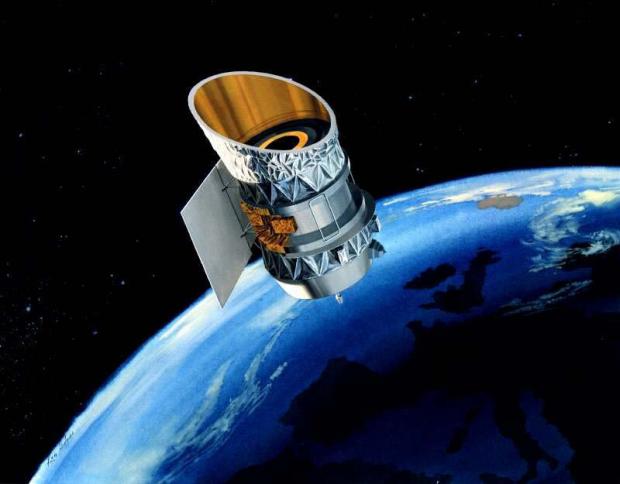
TWO redundant satellites had the space equivalent of a near miss when they passed within a dozen or so metres of each other some 550 miles (900km) above the US state of Pennsylvania on Wednesday night.
The bigger object, about the size of a small car, was an Infrared Astronomical Satellite (IRAS) that was launched in 1983 and was the first space telescope to survey the entire night sky in infrared.
The smaller object was a Gravity Gradient Stabilization Experiment (GGSE) satellite, the fourth of several similar satellites launched in the 1960s.
The GGSE-4 satellite was itself the size of a rubbish bin but covered a bigger area as it trails a 60ft (18 metre) boom designed to deploy antennae or solar sails.
Both continue to be tracked and scientists were able to predict the near miss.
READ MORE: Japan's PM Shinzo Abe to launch space unit in tech defence
WHAT MIGHT HAVE HAPPENED HAD THEY COLLIDED?
HAD they hit head-on, the satellites would have disintegrated and fallen into the earth’s atmosphere where any bits of them would have burned up. There was no danger at any time to anyone on the ground.
The likelihood was a partial collision or sideswipe which could have sprayed debris into orbit around the earth. That is what was really worrying as the debris could have strayed into the orbit of newer and still-working satellites, with possibly horrendous results.
They would have become space junk, but thankfully their close encounter was harmless.
IS SPACE JUNK A THREAT?
ACCORDING to Nasa, there are currently more than 2000 active satellites in orbit around the Earth out of 8000 that have been launched in total, and there are as many as 23,000 bits of debris bigger than 4ins (10cms) such as former satellites and pieces of rocket from more than six decades of space exploration.
That’s as many as can be traced by the US Space Surveillance Network. The truth is nobody actually knows how many bits of small space junk – less than 4ins (10cm) – are out there. One estimate put the number in the tens of millions. Most are travelling at speeds of up to 17,000mph and the majority of pieces of junk are located at up to 500 miles (800kms) from this planet’s surface.
Scientists are very concerned that such junk poses a real threat to future space exploration. The consequences of, say, a future space station colliding with a satellite would be catastrophic for anyone on board the station and it might cause the spacecraft to fall to Earth.
READ MORE: Pat Kane: Could the latest discovery of space signals be aliens?
IS A COLLISION INEVITABLE?
ONE major collision has already happened. A US commercial communications satellite collided with a defunct Russian weather satellite in 2009 and such was the scale of the debris that the crew of the International Space Station (ISS) had to evacuate to the Soyuz capsule – and that was in 2015, six years after the collision. The previous year the ISS had to move three times to avoid other lethally large chunks of space junk.
In January 2007, the Chinese space authorities conducted an anti-satellite missile test, destroying one of the country’s weather satellites with a so-called kill vehicle, sending masses of junk into orbit.
The debris from these two events in 2007 and 2009 is said to account for half of all the debris currently circling Earth, much of which will stay in orbit for many years.
Plans for new “mega-constellations” of satellites, mainly aimed at improving the internet, could see up to 1000 satellites of varying sizes launched into space over the next decade, making future collisions almost inevitable.
The race is on to find a method of dealing with space junk but it will require co-operation between many governments, space agencies and commercial concerns. Hopefully it will not take a tragedy in space to concentrate minds on the problem.




Why are you making commenting on The National only available to subscribers?
We know there are thousands of National readers who want to debate, argue and go back and forth in the comments section of our stories. We’ve got the most informed readers in Scotland, asking each other the big questions about the future of our country.
Unfortunately, though, these important debates are being spoiled by a vocal minority of trolls who aren’t really interested in the issues, try to derail the conversations, register under fake names, and post vile abuse.
So that’s why we’ve decided to make the ability to comment only available to our paying subscribers. That way, all the trolls who post abuse on our website will have to pay if they want to join the debate – and risk a permanent ban from the account that they subscribe with.
The conversation will go back to what it should be about – people who care passionately about the issues, but disagree constructively on what we should do about them. Let’s get that debate started!
Callum Baird, Editor of The National
Comments: Our rules
We want our comments to be a lively and valuable part of our community - a place where readers can debate and engage with the most important local issues. The ability to comment on our stories is a privilege, not a right, however, and that privilege may be withdrawn if it is abused or misused.
Please report any comments that break our rules.
Read the rules here